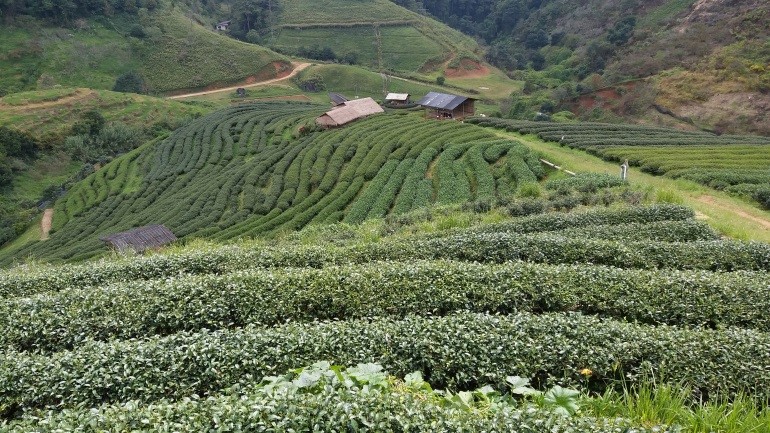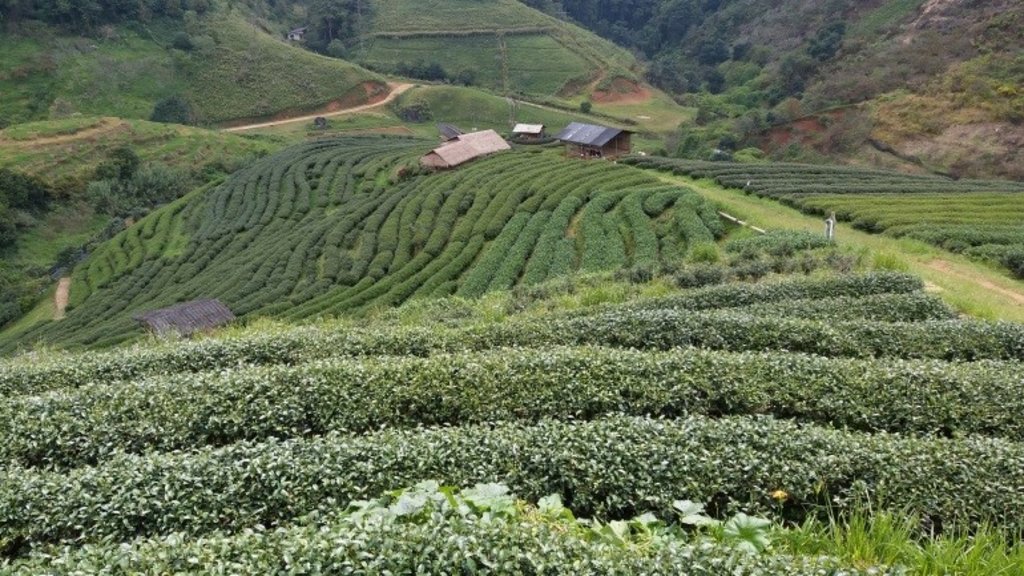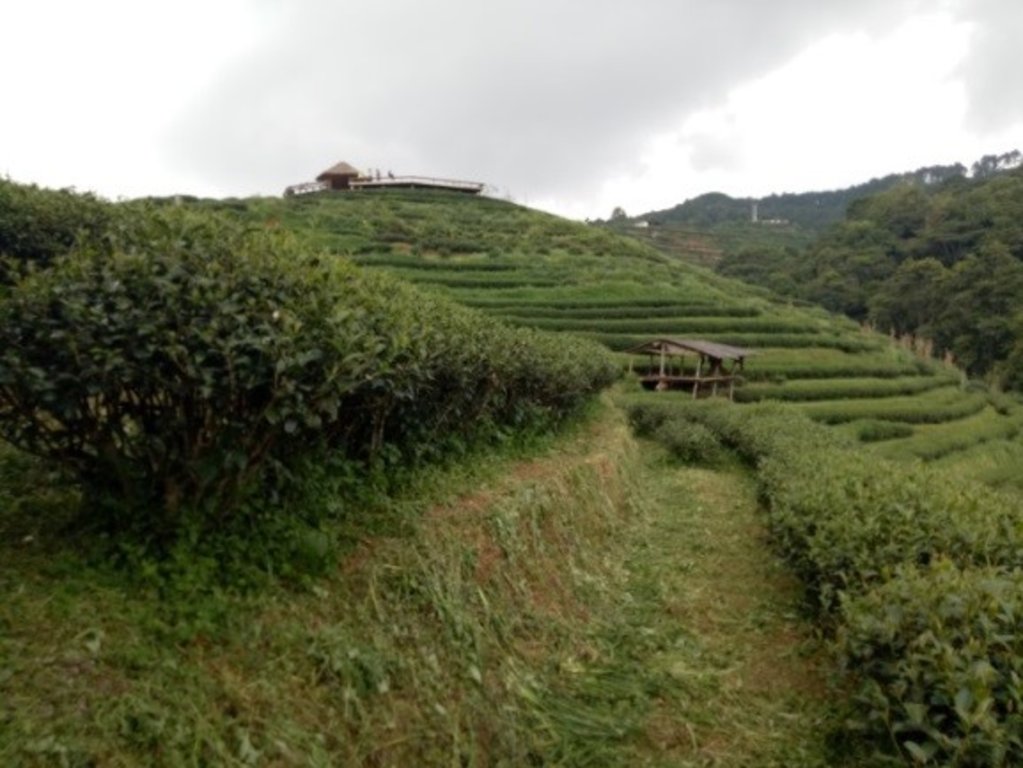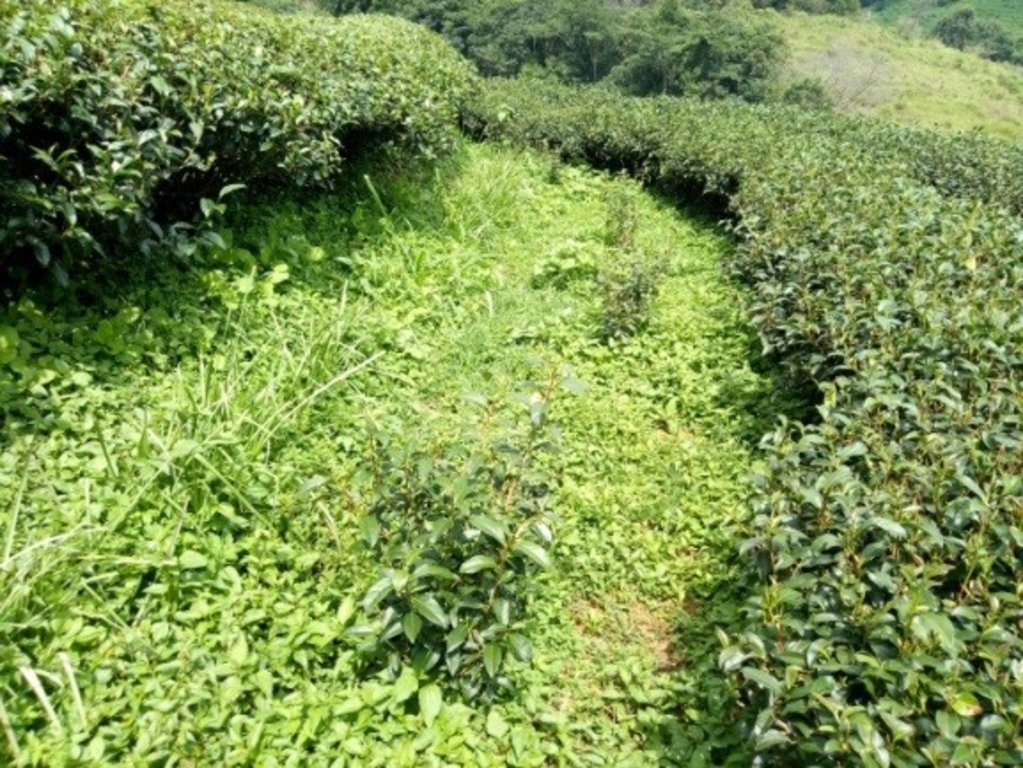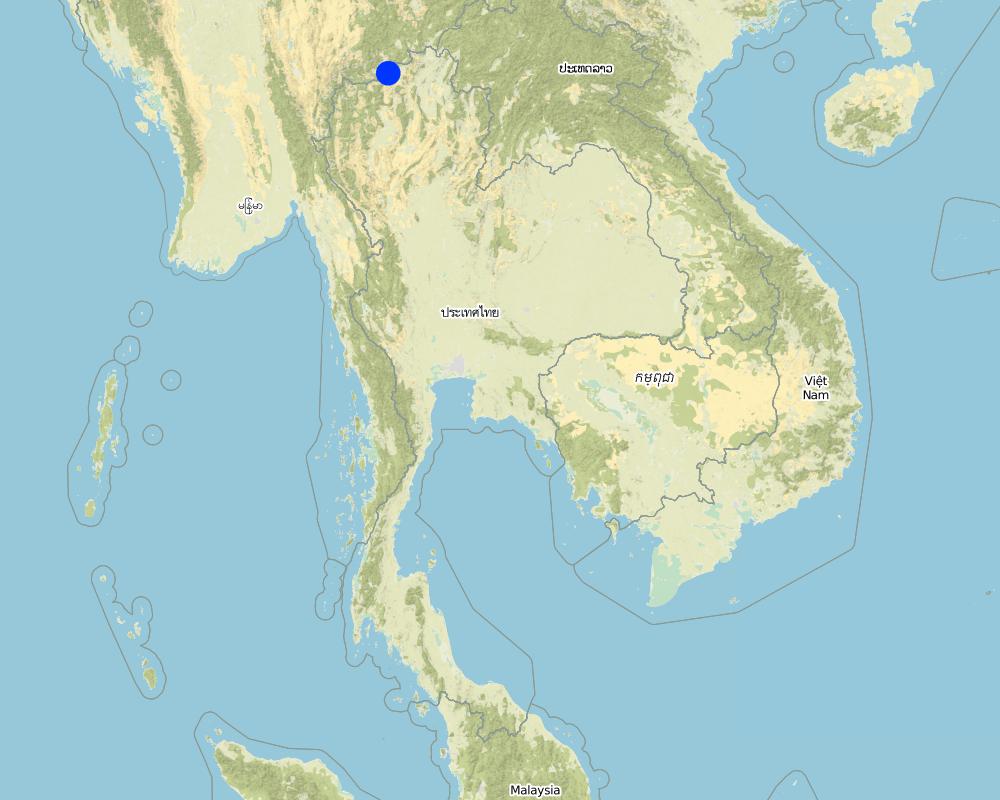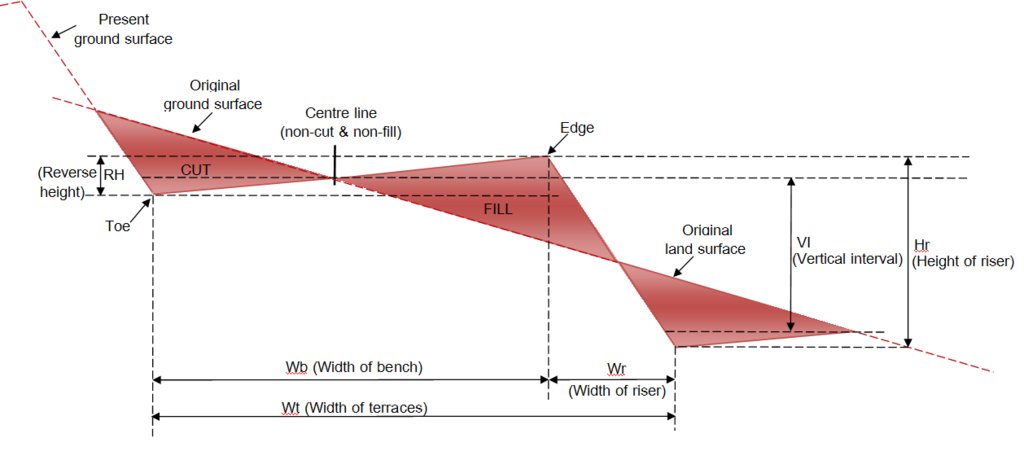Continuous bench terrace in high sloping area for tea plantation [泰国]
- 创建:
- 更新:
- 编制者: Pitayakon Limtong
- 编辑者: –
- 审查者: Rima Mekdaschi Studer
Continuous bench terrace in high sloping area for tea plantation
technologies_4281 - 泰国
查看章节
全部展开 全部收起1. 一般信息
1.2 参与该技术评估和文件编制的资源人员和机构的联系方式
关键资源人
co-compiler:
Tipvong Tanomkwan
Land Development Department
泰国
土地使用者:
Mokngoen Jai
Palaung hill tribe farmer
泰国
Local officer of Station:
Tapangtong Werapong
Angkhang Royal Agricultural Station
泰国
local officer of LDD:
Boonchoo Sontaya
Royal Project Land Development Center, Land Development Department
泰国
有助于对技术进行记录/评估的机构名称(如相关)
Land Development Department (Land Development Department) - 泰国1.3 关于使用通过WOCAT记录的数据的条件
编制者和关键资源人员接受有关使用通过WOCAT记录数据的条件。:
是
1.4 所述技术的可持续性声明
这里所描述的技术在土地退化方面是否存在问题,导致无法被认为是一种可持续的土地管理技术?:
否
注释:
This continuous bench terrace with 3 meters base in slopping highland constructed at Plot 2000 for Chinese tea plantation. Such conservation measure can decrease soil erosion and runoff, and this slopping area can use for agriculture and increase land users products and income.
2. SLM技术的说明
2.1 技术简介
技术定义:
Utilization of continuous bench terrace (3 meters based) as sustainable soil and water conservation measure for tea plantation in slopping area of the northern Thailand
2.2 技术的详细说明
说明:
The continuous bench terrace (forward-sloping terrace) as soil and water conservation measure in the high landscape at Angkhang Royal Agricultural Station, Moo 5, Mae Ngon subdistrict, Fang district, Chiang Mai province was constructed in 1999 in the area of former winter fruit plantation plot of the station. Land Development Department had surveyed, designed and constructed the 3 meters wide of continuous bench terrace, which it is suitable for the tea cultivation and total area is approximately 100 rai. The Angkhang Royal Agricultural Station had selected 50 households of Palaung hill tribe who have more ability and aptitude to grow Chinese tea to participate in the Chinese tea development and promotion project in 2000 and named this area as "Plot 2000". The overview of this area is complex mountainous terrain with slope range 16-30 percent, and average attitude is 1,400 meters above sea level. The soil texture is silty loam and very deep (more tan 1.2 meter), almost well drained soil. The soil organic matter is moderate around 1-3 percent. Moreover, the data of Doi Ang Khang Meteorological Station (Station Code 48302) is located at average attitude 1,529 meters above the sea level, and average temperature throughout the year is 22.9 Celsius with the highest temperature is 32.1 Celsius (during May) and the lowest temperature is 3.9 Celsius (during December), and average annual rainfall is 1,925.3 mm, with rain starting from April to October.
In the past, the watershed areas in northern Thailand have been disturbed by natural disasters, climate change, and human threats. The hill tribe people had invaded the forest to grow opium and shifting cultivation continuously. These condition caused the serious problem in soil erosion, runoff with soil surface, lose of topsoil and plant nutrients, decreasing in soil fertility and productivity with the extremely damage to upstream forest ecosystem. Until in the year 1969, Angkhang Royal Agricultural Station was established from the initiative of His Majesty King Rama 9, which aimed to conduct research on the planting of winter economic crops as an example for hill tribe to plant those crops as their career instead of opium cultivation, and also stop cutting and shifting cultivation. Nowadays there are more than 50 species of economic plants in this project and generating more income for land users, more than that this slopping area is the sustainable in land use and land management under organization of the Royal Project Foundation.
The benefits this technology is important in sustainable utilization of land resources in this area, and all land users around the Angkhang Royal Agricultural Station have stable and more income because they can grow Chinese tea and also other winter economic crops on this highland throughout the year. Moreover, this continuous bench terrace is more convenient for land users in fertilizer application, soil improvement, machines operation, tea harvesting and also yield transportation from cultivated plots to local processing factory.
The impact of implementation continuous bench terrace with 3 meters based:
1. The obvious economic and social impacts of land users are the stability of income from the production of Chinese tea, which are produced throughout the year. This conservation is more convenient for land users to implement in their plot and also transport from cultivated plots to local processing factory. The local officers from Angkhang Royal Agricultural Station and others government agencies closely advised and guided breeding, planting, soil management, harvesting and price guarantee.
2. The environmental and ecological impact is to reduce the amount of runoff and soil sediment, increase soil moisture, preserve soil nutrients and fertility, encourage biodiversity in the area of Plot 2000.
3. The society and culture impact is all ethnic groups are given the opportunity to receive the allocation of arable land according to the group of plants that they are comfortable and want to produce. Thus respecting the use of land in zoning as allocated from the station, including right to use water. These caused the strength of community institutions, where they have various crop production groups, organic fertilizer production Group and others. They are all member of the cooperative of the community.
2.3 技术照片
关于照片的一般说明:
Soil and water conservation measure (3-meter base) as continuous bench terrace with Chinese tea cultivation on highland (at Plot 2000). The winter fruit trees in this area of AngKhang Royal Agricultural Station has been changed to the bench terrace for Chinese tea plantation with good agricultural practices (GAP) more than 19 years, which shows the appropriate land use conditions in sustainable soil and water conservation.
2.4 技术视频
日期:
14/10/2018
位置:
Ban Thap Sub-District, Mae Chaem District, Chiang Mai Province, 50270
摄影师的名字:
Ms. Somjit Lertdisayawan / Ms. Tanomkwan Tipvong
2.5 已应用该技术的、本评估所涵盖的国家/地区/地点
国家:
泰国
区域/州/省:
Ban Thap Sub-District, Mae Chaem District, Chiang Mai Province, 50270
有关地点的进一步说明:
Extension area for Chinese tea plantation (Plot 2000) at Angkhang Royal Agricultural Station, Mae Ngon Subdistrict, Fang District, Chiang Mai ProvincePlot
具体说明该技术的分布:
- 均匀地分布在一个区域
如果不知道精确的区域,请注明大致覆盖的区域:
- 0.1-1 平方千米
注释:
Angkhang Royal Agricultural Station is an area for research and development for the winter crops and trees around 1,811 rai, with high from the sea level 1,400 meters. There are hill tribe villages around the station and the total population is about 3,215 people. The weather is cool all year round with the average temperature is 17.7 degrees, the maximum temperature is 32 degrees in April. And the minimum temperature of -3 degrees in January. The average rainfall is 2,075 mm per year and slope area 20-35%.
Map
×2.6 实施日期
注明实施年份:
1999
如果不知道确切的年份,请说明大概的日期:
- 10-50年前
2.7 技术介绍
详细说明该技术是如何引入的:
- 通过项目/外部干预
注释(项目类型等):
The Royal Project implement in the upstream forest area and emphasize to promote and encourage career of hilltribe land users around AngKhang Agricultural Station. Moreover, the continuous bench terrace is introduced in this high slope area to prevent and conserve soil and water resources, reduce soil erosion and runoff.
3. SLM技术的分类
3.1 该技术的主要目的
- 改良生产
- 减少、预防、恢复土地退化
- 保护生态系统
- 保持/提高生物多样性
- 创造有益的经济影响
3.2 应用该技术的当前土地利用类型

农田
- 多年一作(非木材)
- Tea
每年的生长季节数:
- 1
具体说明:
Chinese tea, Camellia sinensis var. sinensis in 15.43 sq.km. or 96.4375 Rai.
注释:
Palaung hill tribe will plant Chinese tea on this area in late rainy season, about August to October because after planting root of tea would grow well in the cool condition and do not face problems like during the rainy season. The trimming will be about 10-12 months before planting. spacing between row is 1.2 meter and between tree is 60 centimeters. There are about 2,200 trees per Rai.
3.3 由于技术的实施,土地使用是否发生了变化?
注释:
-
3.4 供水
该技术所应用土地的供水:
- 混合雨水灌溉
注释:
The land use in this area is Chinese tea in Plot 2000, with 2 species, namely soft stalks and variety no.12, This area is mainly rain fed together with spraying system. And water supply system is in the upper part of the area and distribute to tea plot by PVC pipe and set springier cover over this plot. however, this water system is high cost but it is worthwhile.
3.5 该技术所属的SLM组
- 横坡措施
- 减少基于生态系统的灾害风险
3.6 包含该技术的可持续土地管理措施

植物措施
- V2:草和多年生草本植物

结构措施
- S1:阶地
注释:
The continuous bench terrace technology is suitable soil and water conservation in slopping area,where is the upper part of watershed in the National Reserved Forest area. This technology need knowledge and expertise in construction of conservation measure with high investment and more maintenance. That means government and private sector should support in construction and land users should maintain of bench terrace and take care in soil fertility.
3.7 该技术强调的主要土地退化类型

土壤水蚀
- Wt:表土流失/地表侵蚀
注释:
Soil resources in this area is degraded by deforestation and climate changes, where it is risk in runoff and soil erosion. In this case plant nutrients in soil surface and sediment is removed to the low part, soil fertility is decreased, and ecosystem in upstream forest is degraded.
3.8 防止、减少或恢复土地退化
具体数量名该技术与土地退化有关的目标:
- 防止土地退化
- 减少土地退化
注释:
In 1999, the Angkhang Royal Agricultural Station cooperated with Land Development Department construct the continuous bench terrace and soil improvement in this steep slope area to prevent soil erosion and runoff. Moreover, the Royal Irrigation Department support water supply system and the Provincial Electricity Authority support electricity services.
4. 技术规范、实施活动、投入和成本
4.1 该技术的技术图纸
技术规范(与技术图纸相关):
Operation in tea plantation in Plot 2000:
1. During 1999-2000, Angkhang Royal Agricultural Station, in collaboration with Land Development Department, conducted a survey to select the highland mountainous area with slope 20-35 percent, where land is deteriorated conditions, risk of erosion and landslides, low fertility. In order to design and construct soil and water conservation measure as continuous bench terrace with 3 meters based for Chinese tea plantations as a plot to demonstrate and promote the conservation measure on such area for Palaung hill tribe. Soil in this area is Mae Taeng soil series where it is very deep soil, with texture is sandy loam to sandy loamy, dark brown in color and soil reaction is slightly acidic (pH 5.5-6.5). In lower layer of soil profile is clay, dark red to red and soil reaction is very acidic to acidic (pH 4.5-5.5)
2. Set up the digging contour line by using wood pole from the highest point of the area to the lowest point and used the upper line is the first line of the terrace. Then dig the next contour line down along the slope and distance between the contour line is equal to distance of each terrace that is 3 meters. After that dig the terrace as 3 meters based on the contour line and set the level of terrace inclined around 1-2 degrees to drain water from this area.
3. The operation of cut and fill of soil along the contour line and move the surface soil and reshape the surface soil in this area. And dig the soil by using manpower or machine from the lower edge of the plot to make the terrace in the upper part. Therefore move, adjust and compact the soil in this area and reshape surface of soil and make terrace with 3.0 meters width and incline about 1-2 degrees, and make additional 10 percent of soil thickness to prevent the collapse, and keep the soil organic matter on the upper part of the floor and height of each terrace should not more than 1.8 meters, therefore cutting the soil down to 0.9 meters and filling the soil 0.9 meters.
4. Vetiver grass plantation conserved 2 rows of terrace by planting over the top of the terrace and planting another 1 row over the filled soil and planting spacing is 10 centimeters.
5.1 After bench terrace construction is completed in 2000, where Angkhang Royal Agricultural Station selected land users and allocated land for tea plantation for 50 households of Palaung hill tribe to set experiment of 2 varieties of Chinese tea as soft stem and breed number 12 varieties.
5.2 Land users usually planted Chinese tea at late of rainy season, which is about August to October as suitable planting season. Because after planting in this period, the root of the tea will affect the cold condition that make they grow well and do not face problems like during the rainy season
5.3 The planting period of the cutting stalk will be about 10-12 months before planting. The planting spacing is 1.2 meters in length. The spacing between stalk is 60 centimeters, and spaced about 40-45 centimeters in a row. There are approximately 2,200 trees per rai.
6. Maintenance of Plot 2000
6.1 Fertilizer application focuses on using compost from animal manure produced by this group. By digging a long groove at the end of the canopy of tea about 15 cm deep on both sides. Compost is applied 2 kilograms per tree a year, and apply 3 times during February, June, October and also use bio-extracted solution spray to tea tree for stretching the shoot with dark green leaf, plump, good weight.
6.2 Irrigation in this area use both from rain and water storage tank in the upper area and distribute directly to the plot by PVC pipe.
6.3 Almost land users in this area harvested their organic tea from April to December and will donant during January-March. At present, the no.12 variety has average yield 800 kilograms per rai, they can harvest 5-6 times a year, while the soft stem variety has average yield 600 kilograms per rai, and can harvest 4-5 times a year. In this case they would have total annual yield 60,000 kilograms and annual average income is 100,000-300,000 baht per household.
7. Maintenance of bench terrace in case of damage by runoff, all land users will repair their terrace by themselves in the dry season. In the serious case of erosion, Land Development Department will support such maintenance at rate of 500 baht per rai.
作者:
Ms. Tanomkwan Tipvong
4.2 有关投入和成本计算的一般信息
具体说明成本和投入是如何计算的:
- 每个技术区域
注明尺寸和面积单位:
The area of continuous bench terrace 3 meter board
如果使用本地面积单位,注明转换系数为1公顷(例如1公顷=2.47英亩):1公顷=:
15.43
其它/国家货币(具体说明):
Baht
如相关,注明美元与当地货币的汇率(例如1美元=79.9巴西雷亚尔):1美元=:
15448.6
注明雇用劳工的每日平均工资成本:
175.82
4.3 技术建立活动
| 活动 | 时间(季度) | |
|---|---|---|
| 1. | Survey, select the area and design conservation measure | the first year (1998) |
| 2. | set up contour line for terrace | the first year (1998) |
| 3. | construct bench terrace | before of rainy season 1999 |
| 4. | Vetiver grass plantation on the terrace | early of rainy season 1999 |
| 5. | Chinese tea plantation | in rainy season, Aug-Oct 2000 |
| 6. | Fertilizer application 3 times | Feb, Jun and Oct |
| 7. | Water application | throughout the planting period |
| 8. | Fertilizer application | throughout the planting period |
| 9. | Harvest | harvesting period |
| 10. | Maintenance bench terrace | in dry season, April |
注释:
-
4.4 技术建立所需要的费用和投入
| 对投入进行具体说明 | 单位 | 数量 | 单位成本 | 每项投入的总成本 | 土地使用者承担的成本% | |
|---|---|---|---|---|---|---|
| 劳动力 | site survey 1 day | man | 0.5 | 175.82 | 87.91 | |
| 劳动力 | set up contour line 1 day | man | 4.0 | 175.82 | 703.28 | |
| 劳动力 | vetiver planting (400 slips x 8 rows) | slip | 3200.0 | 1.65 | 5280.0 | |
| 劳动力 | man power (2.4 cu.m./m.) | cu.m. | 88.0 | 100.88 | 8877.44 | |
| 设备 | machine power (2.4 cu.m./m.) | cu.m. | ||||
| 设备 | pin wood | unit | 100.0 | 5.0 | 500.0 | |
| 植物材料 | vetiver slip (LDD supported) | None | 3200.0 | |||
| 技术建立所需总成本 | 15448.63 | |||||
| 技术建立总成本,美元 | 1.0 | |||||
如果土地使用者负担的费用少于100%,请注明由谁负担其余费用:
Land Development Department by Center of land development for Royal Project supported the budget by conduct the bench terrace in this area.
注释:
-
4.5 维护/经常性活动
| 活动 | 时间/频率 | |
|---|---|---|
| 1. | maintain and repair bench terrace | in dry season 3-5 years/time |
注释:
In the case of bench terrace are not so much damaged, and size of rill is around 5-20 cm. wide and not very deep. Most of the land users usually repair that terrace by themselves during the dry season.
4.6 维护/经常性活动所需要的费用和投入(每年)
| 对投入进行具体说明 | 单位 | 数量 | 单位成本 | 每项投入的总成本 | 土地使用者承担的成本% | |
|---|---|---|---|---|---|---|
| 劳动力 | man power to repair the terrace | man | 1.0 | 500.0 | 500.0 | 100.0 |
| 技术维护所需总成本 | 500.0 | |||||
| 技术维护总成本,美元 | 0.03 | |||||
如果土地使用者负担的费用少于100%,请注明由谁负担其余费用:
All maintenance cost of bench terrace are supported by Center of Land Development for Royal Project, Land Development Department.
注释:
Center of Land Development for Royal Project, Land Development Department directly cooperated with the Royal Project.
4.7 影响成本的最重要因素
描述影响成本的最决定性因素:
construction of continuous bench terrace and maintenance cost, which it is all invested by government sector, Land Development Department.
5. 自然和人文环境
5.1 气候
年降雨量
- < 250毫米
- 251-500毫米
- 501-750毫米
- 751-1,000毫米
- 1,001-1,500毫米
- 1,501-2,000毫米
- 2,001-3,000毫米
- 3,001-4,000毫米
- > 4,000毫米
指定年平均降雨量(若已知),单位为mm:
1925.30
有关降雨的规范/注释:
The number of rainy day is 160.9 days per year. The day with the highest daily rain (daily max.) average 149.4 mm/day in October. The number of day has storm average of 57.5 days and highest per year in May is 10.5 days
注明所考虑的参考气象站名称:
Doi Angkang (Index station 48302), 19° 55' 53.0" N and 99° 2' 54.0" E, at attitude MSL 1529 m. (2006-2015)
农业气候带
- 半湿润
According to data from climatic station 48302 , it is found that the duration of the precipitation period is more than half of the evaporation potential (PET) between May-October or about 6 months (180 days).
5.2 地形
平均坡度:
- 水平(0-2%)
- 缓降(3-5%)
- 平缓(6-10%)
- 滚坡(11-15%)
- 崎岖(16-30%)
- 陡峭(31-60%)
- 非常陡峭(>60%)
地形:
- 高原/平原
- 山脊
- 山坡
- 山地斜坡
- 麓坡
- 谷底
垂直分布带:
- 0-100 m a.s.l.
- 101-500 m a.s.l.
- 501-1,000 m a.s.l.
- 1,001-1,500 m a.s.l.
- 1,501-2,000 m a.s.l.
- 2,001-2,500 m a.s.l.
- 2,501-3,000 m a.s.l.
- 3,001-4,000 m a.s.l.
- > 4,000 m a.s.l.
说明该技术是否专门应用于:
- 不相关
关于地形的注释和进一步规范:
This technology is used in slope 20-35% , slope complex and slope more than 35%.
5.3 土壤
平均土层深度:
- 非常浅(0-20厘米)
- 浅(21-50厘米)
- 中等深度(51-80厘米)
- 深(81-120厘米)
- 非常深(> 120厘米)
土壤质地(表土):
- 中粒(壤土、粉土)
土壤质地(地表以下> 20厘米):
- 细粒/重质(粘土)
表土有机质:
- 中(1-3%)
如有可能,附上完整的土壤描述或具体说明可用的信息,例如土壤类型、土壤酸碱度、阳离子交换能力、氮、盐度等。:
Angkhang Royal Agricultural Station is directly respond covered 16,577 rai, with 5 main villages, namely Ban Nala, Ban Rim, Ban Pang Ma, Ban Khum, and Ban Luang. Total population is 3,929 people. The overall landscape is slope complex in mountain range surrounded by a pan-shaped basin. This agricultural area is promoted the hill tribe community to grow winter crops. The general condition of this area is pine forest and evergreen forest. The attitude is 1,400 meters above the sea level. Most of soil series are Ban Luang Series. Soil loamy soil. Angkhang Series is a soil formed by limestone, rock, shell, shale. The overall soil condition is good structure, but almost highland with high slope and acidic condition (pH 4.5-6.0).
5.4 水资源可用性和质量
地下水位表:
> 50米
地表水的可用性:
好
水质(未处理):
仅供农业使用(灌溉)
水的盐度有问题吗?:
否
该区域正在发生洪水吗?:
否
关于水质和水量的注释和进一步规范:
In the past, there was no soil and water conservation measure, where soil erosion and severe runoff is occurred when it has heavy rain, especially during the rainy season. Soil surface was transported to the lower part, where organic matter and plant nutrients lost from this area and small rill and deep groove is formed in the upper part. Moreover such soil sediment in runoff accumulated in the channel and natural reservoir.
5.5 生物多样性
物种多样性:
- 高
栖息地多样性:
- 中等
关于生物多样性的注释和进一步规范:
In Plot 2000 can observe several insects in both of predators and parasitic insects such as dragonflies, beetles, turtles, striped mungs, ants, also earthworm and others.
5.6 应用该技术的土地使用者的特征
定栖或游牧:
- 定栖的
生产系统的市场定位:
- 混合(生计/商业)
非农收入:
- 低于全部收入的10%
相对财富水平:
- 平均水平
个人或集体:
- 团体/社区
机械化水平:
- 手工作业
性别:
- 女人
- 男人
土地使用者的年龄:
- 青年人
- 中年人
- 老年人
说明土地使用者的其他有关特征:
All land users and their family members worked in their land such as tea leaves harvest, weed control, fertilizer application, tea planting, trimming and others, which they would not prefer to hire workers.
5.7 应用该技术的土地使用者使用的平均土地面积
- < 0.5 公顷
- 0.5-1 公顷
- 1-2 公顷
- 2-5公顷
- 5-15公顷
- 15-50公顷
- 50-100公顷
- 100-500公顷
- 500-1,000公顷
- 1,000-10,000公顷
- > 10,000公顷
这被认为是小规模、中规模还是大规模的(参照当地实际情况)?:
- 小规模的
注释:
The leader of Plot 2000 (Mr. Chai) has land for tea plantation 4 rai. and also Jiaogulan herb plantion 1 rai, and rental land for agriculture 1 rai.
5.8 土地所有权、土地使用权和水使用权
土地所有权:
- 个人,未命名
土地使用权:
- 社区(有组织)
用水权:
- 社区(有组织)
具体说明:
-
注释:
All land users in this area would not right in land ownership but they have right to use these land for agricultural purposes. And Angkhang Royal Agricultural Station separated and allocated these land for selected land users and also land zoning for fruit trees, Vegetables, flowers and ornamental plants and others.
5.9 进入服务和基础设施的通道
健康:
- 贫瘠
- 适度的
- 好
教育:
- 贫瘠
- 适度的
- 好
技术援助:
- 贫瘠
- 适度的
- 好
就业(例如非农):
- 贫瘠
- 适度的
- 好
市场:
- 贫瘠
- 适度的
- 好
能源:
- 贫瘠
- 适度的
- 好
道路和交通:
- 贫瘠
- 适度的
- 好
饮用水和卫生设施:
- 贫瘠
- 适度的
- 好
金融服务:
- 贫瘠
- 适度的
- 好
注释:
They have cooperative activity to support investment and production costs such as fertilizers, bio-pesticides, pesticides and others.
6. 影响和结论性说明
6.1 该技术的现场影响
社会经济效应
生产
作物生产
注释/具体说明:
In former time land users use shifting cultivation for corn and upland rice. After organic tea farming had set up at Plot 2000 their products and income were increased and can harvest throughout the year.
生产故障风险
注释/具体说明:
They have advised from stations' staff and promote varieties, planting, production, harvest, purchase, insurance price. There are tea processing factories in the market, making tea production sustainable (integrated)
生产区域
注释/具体说明:
this area can not extend.
土地管理
注释/具体说明:
After this system has been allocated for organic tea in the Plot 2000, where soil conservation measure and soil management is need.
水资源可用性和质量
灌溉用水需求
注释/具体说明:
This system need more water continuously.
收入和成本
农业投入费用
注释/具体说明:
This system need to maintain the terrace and more work to take care tea tree.
农业收入
注释/具体说明:
They have more income from tea product continuously.
经济差异
注释/具体说明:
They have equal opportunities in earning their life.
工作量
注释/具体说明:
They have more workload almost daily and continuously because they need to intensive care on terrace construction and tea tree.
社会文化影响
土地使用权/用水权
注释/具体说明:
This system had set up zoning system for some crop by Angkhak Station, and also management in right to water utilization.
社区机构
注释/具体说明:
They have strong cooperatives and all members are the land users in this area. There are various crop production groups and organic fertilizer production group.
SLM/土地退化知识
注释/具体说明:
Almost land users in this area know very well about soil erosion in hillside with slopping area. and realizing that bench terrace can solve these problem and make it sustainable condition.
社会经济弱势群体的情况
注释/具体说明:
Every ethnic group has been given the opportunity to receive the allocated land according to their experience and knowledge in each crop.
生态影响
水循环/径流
地表径流
注释/具体说明:
This system can reduce amount of water runoff and store some water into the soil..
土壤
土壤水分
注释/具体说明:
This system can store more water into the soil, and soil moisture are in soil layer longer.
土壤覆盖层
注释/具体说明:
The system would have more ground cover crops.
土壤流失
注释/具体说明:
The bench terrace is very effective in prevention of soil erosion and water storage.
土壤堆积
注释/具体说明:
In the upper part almost soil are accumulated in the bench terrace, that means soil fertility and nutrient still stay in the slopping area.
生物多样性:植被、动物
植被覆盖
注释/具体说明:
The system makes more crops covered soil surface throughout the year.
有益物种
注释/具体说明:
The system improve small animals and insects in soil such as earthworms, bees, dragonflies, spiders, ladybugs and others.
害虫/疾病控制
注释/具体说明:
They emphasized in organic farming, so they need to have more technical advised in natural products for pest and insect control.
减少气候和灾害风险
滑坡/泥石流
注释/具体说明:
The system can reduce in both of amount of runoff and soil sediment to the lower part.
对现场影响的评估(测量)进行具体说明:
almost land users have been continuously advised in tea plantation and organic farming by local officers of the Station.
6.2 该技术的场外影响已经显现
下游洪水
注释/具体说明:
-
下游淤积
注释/具体说明:
-
对场外影响(测量)的评估进行具体说明:
-
6.3 技术对渐变气候以及与气候相关的极端情况/灾害的暴露和敏感性(土地使用者认为的极端情况/灾害)
气候有关的极端情况(灾害)
气象灾害
| 该技术是如何应对的? | |
|---|---|
| 局地暴雨 | 非常好 |
水文灾害
| 该技术是如何应对的? | |
|---|---|
| 滑坡 | 好 |
注释:
-
6.4 成本效益分析
技术收益与技术建立成本相比如何(从土地使用者的角度看)?
短期回报:
积极
长期回报:
非常积极
技术收益与技术维护成本/经常性成本相比如何(从土地使用者的角度看)?
短期回报:
积极
长期回报:
非常积极
注释:
Land users no need to pay any expenses. So the construction of bench terrace as 3 m. basement is set up by the Royal Project for Land Development Center.
6.5 技术采用
- 11-50%
如若可行,进行量化(住户数量和/或覆盖面积):
In Plot 2000 , They have 39 members who cultivated tea and medicinal plants in this bench terrace.
在所有采用这项技术的人当中,有多少人是自发的,即未获得任何物质奖励/付款?:
- 0-10%
注释:
This bench terrace need more investment and management, and need more incentives.
6.6 适应
最近是否对该技术进行了修改以适应不断变化的条件?:
否
6.7 该技术的优点/长处/机会
| 土地使用者眼中的长处/优势/机会 |
|---|
| The continuous bench terrace is high effective measure to slow down runoff, reduce sediment and soil erosion. |
| This system would reduce amount of fertilizer application, which organic matter and plant nutrients still stay in the slopping area. |
| All land users can produce more agricultural products and more income. |
| 编制者或其他关键资源人员认为的长处/优势/机会 |
|---|
| The continuous bench terrace is high effective measure to slow down runoff, reduce sediment and soil erosion. |
| This bench terrace increase amount of storage water into soil, and also increase soil moisture content. And the excess of rain would gradually control and drain to water way. |
| This technology would reduce amount of fertilizer application due to prevent of plant nutrients lost from this area. |
| All land users can improve their life status in increasing agricultural products and income. |
6.8 技术的弱点/缺点/风险及其克服方法
| 土地使用者认为的弱点/缺点/风险 | 如何克服它们? |
|---|---|
| The continuous bench terrace is very high cost | Government and local officers support this activities. |
| This system need expert in design and implement. | Local government officers (LDD) support and service this activities. |
| The structure of bench terrace is damaged. | Local government officers (LDD) support and service this activities. |
| 编制者或其他关键资源人员认为的弱点/缺点/风险 | 如何克服它们? |
|---|---|
| The continuous bench terrace is very high cost and need machine to construct is terrace. | Government and local officers support this activities. |
| This system need expert in design and implement. | Local government officers (LDD) support and service this activities. |
| The structure of bench terrace is damaged by heavy rain, runoff and other events. | Local government officers (LDD) support and service this activities. |
7. 参考和链接
7.1 信息的方法/来源
- 实地考察、实地调查
1
- 与土地使用者的访谈
1
- 与SLM专业人员/专家的访谈
2
- 根据报告和其他现有文档进行编译
-
(现场)数据是什么时候汇编的?:
14/10/2018
注释:
More detail information is available at the Royal Project.
7.2 参考可用出版物
标题、作者、年份、ISBN:
-
可以从哪里获得?成本如何?
-
7.3 链接到网络上的相关信息
标题/说明:
Continuous bench terrace for soil and water conservation in watershed area (at slope 35-60%)
URL:
http://www.dnp.go.th/watershed/ส่วนอำนวยการ/จัดทำระบบอนุรักษ์ดินและน้ำ โครงการทำขั้นบันไดดิน.pdf
7.4 一般注释
-
链接和模块
全部展开 全部收起链接
无链接
模块
无模块


